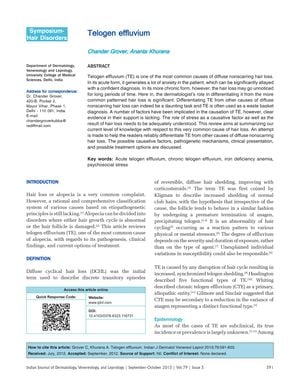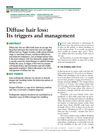Telogen Effluvium: A Review of Acute and Chronic Forms
January 2013
in “
Indian Journal of Dermatology, Venereology and Leprology
”

TLDR Chronic Telogen Effluvium may resolve after years and is diagnosed by examining the patient's history and clinical signs, with treatment aimed at underlying causes and possibly minoxidil.
The document from 2013 reviews Telogen Effluvium (TE), a common form of hair loss where hair follicles prematurely enter the resting phase, leading to increased shedding. It distinguishes between Acute Telogen Effluvium (ATE), which usually resolves within months, and Chronic Telogen Effluvium (CTE), which can last over 6 months and is often seen in middle-aged women. Diagnostic methods include the hair pull test and scalp biopsies, which help differentiate CTE from Androgenetic Alopecia (AGA). The document notes the potential role of UV light in hair loss and the importance of ruling out other causes like thyroid disorders and iron deficiency anemia (IDA). It also discusses the complex relationship between iron deficiency without anemia and hair loss. The document concludes that CTE is believed to be self-limited and may resolve after a decade or so, but requires thorough history and clinical examination for diagnosis and differentiation from other hair loss conditions. Treatment focuses on reassurance, addressing underlying causes, and potentially using minoxidil, with no proven benefit from vitamins or supplements unless a deficiency is present.





